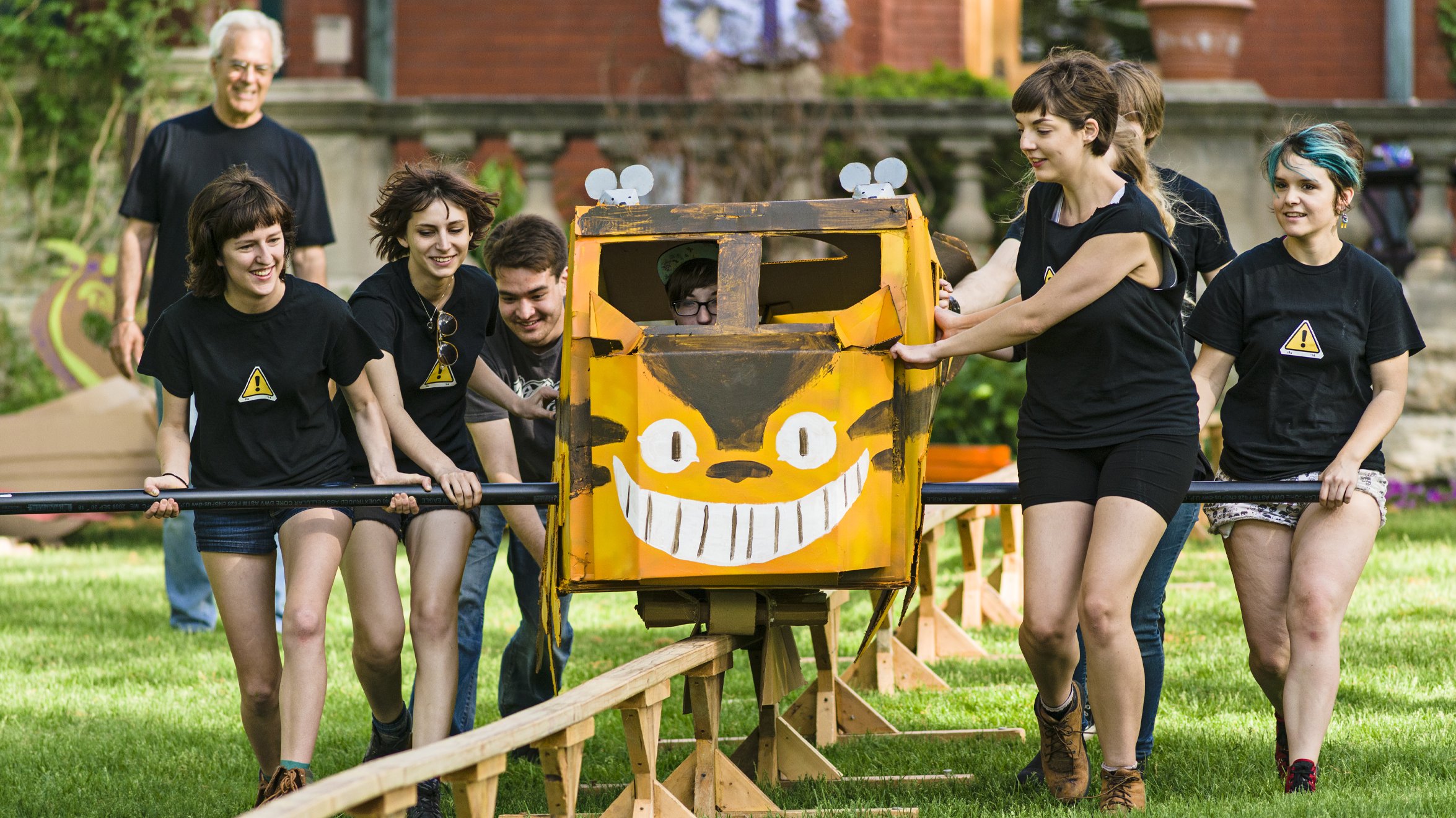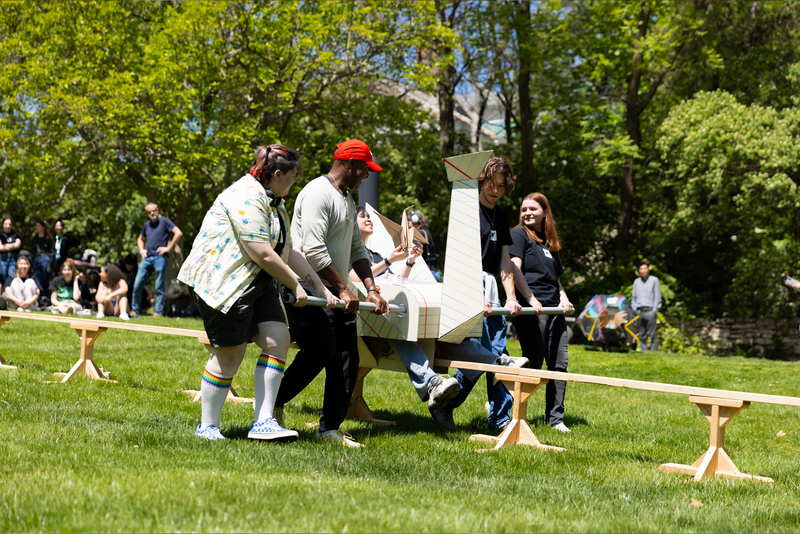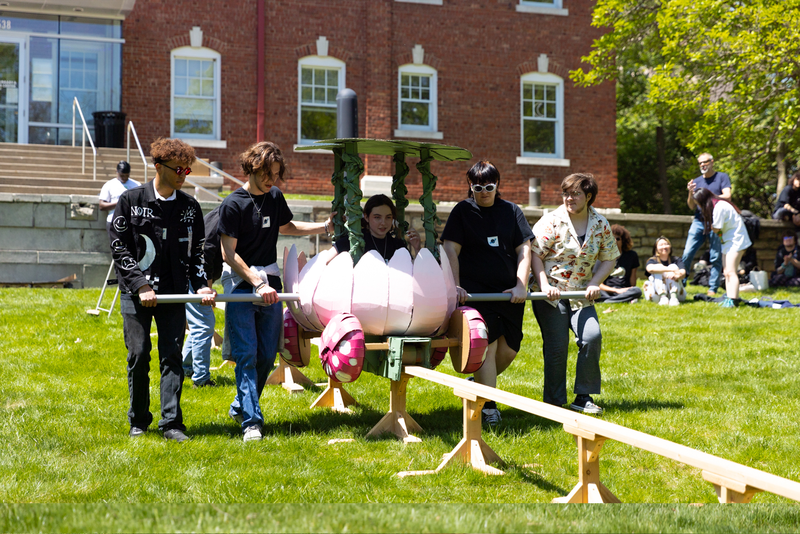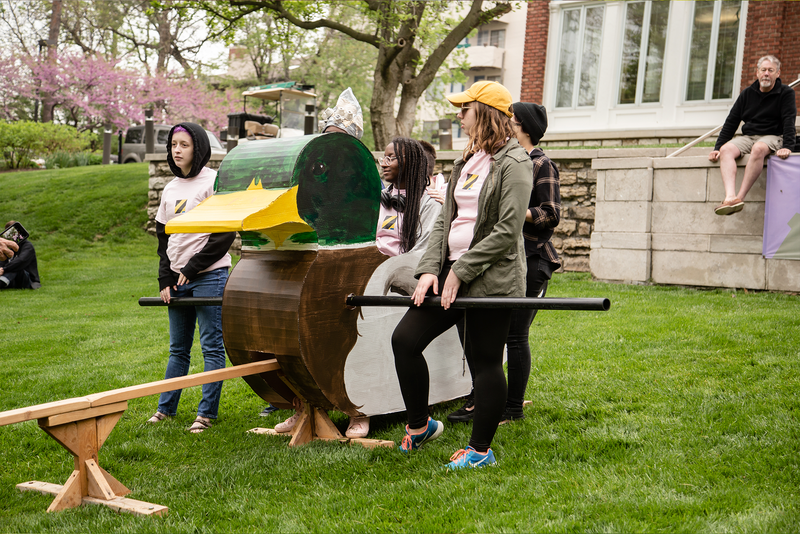
Illustrating Balance: Rail Day at KCAI
02.03.2025
Rail Day at the Kansas City Art Institute challenges Illustration students to design and build cardboard vehicles able to navigate an 80-foot-long rail. It's a hands-on exercise in creativity, problem-solving, collaboration and team-building.
Rail Day 2025
May 2, 2025 @ 12 PM
Jannes Library Front Lawn
Kansas City Art Institute
4415 Warwick Blvd, Kansas City, MO 64111
Cardboard Creativity
At the age of 10, Steve Mayse stood at the precipice of Powerhouse Hill. For a young boy growing up in Plattsburg, Missouri, it might as well have been the top of the world—with one foot on the near vertical pavement, the other on a homemade rig of some sort.
“We’d take old skates or an assortment of baby buggy wheels from the dump and nail them on anything. Dangerous stuff,” he laughs, reflecting on his resourceful, impoverished youth decades later from the safety of his office at the Kansas City Art Institute. The creative risks he embraces today may have stemmed from the physical risks he took as a child.
“I remember thinking after an initial run down the hill, ‘Let’s slow this thing down because that’s a pretty steep hill...What I didn’t realize was when I added a cinder block as a brake system, it increased the weight and mass.”
“It was a disaster,” Mayse said. “Most of our hot rods disintegrated at the railroad track which was near the bottom of the hill. Live and learn.”
Today, the track as a concept is no longer an obstacle or enemy—it’s the centerpiece of Rail Day, an annual event at KCAI where Illustration students design, build, and test their own cardboard vehicles down a single mono-beam. The concept of the assignment came from the mind of Mayse. “I just wanted to ask something really simple, meaning I just wanted to see how they might similarly think and approach the physics of it all.”
I think I can, I think I can...
Rail Day started in the spring of 1996 as part of an elective class called Image and Form Exploration. Mayse wanted students to engage with sculpture and three-dimensional design, but his goal was bigger than just completing an assignment—it was about how they interacted with the process. As he explains, the goal was for students to not only create something functional but to physically engage with their work and the world around them.
“And then I thought, how could they be part of it? Not just create it externally, but how can they be part of the 3-dimensional form itself?”
Here’s how it works now—and it hasn’t changed much since the beginning: this year, the sophomore students in the Analytical Drawing Systems class will start working on their “vehicles” on April 16. The challenge? To design and build a vehicle made solely from cardboard, glue, and paper—no nails, staples, or tape—that must navigate an 18-inch-high, 80-foot-long rail.
Mayse provides guidance on certain components, such as explaining default systems for housing, axles, and bearings to prevent students from feeling too overwhelmed. He encourages them to use materials like pre-cut cardboard carpet rolls as a starting point, while still leaving room for experimentation and creative solutions if they wish to design an alternative system.
“One student designed some kind of airplane-like vehicle that had a hole where the student would manually reload multiple bearings into the vehicle’s system as it progressed down the rail,” Mayse said, noting it was far from conventional and extremely inefficient—yet, an impressive solution in the process, nonetheless.

"I thought, how could they be part of it? Not just create it externally, but how can they be part of the 3-dimensional form itself?"
What to Expect When You're Connecting
Rail Day is underway. Students, faculty, and members of the public have gathered on the front lawn of Jannes Library at the Kansas City Art Institute waiting for the vehicles to begin their journeys. Mayse’s only direction for the 80-foot rail he designed is simple: 'You have to get from here to there, don’t care how you do it.'"
Although some students chose to operate solo, most students work in teams of two. One of the students assumes the "pilot" position, while the other students help maintain balance as the vehicle moves down the rail. As Mayse notes, "It’s got to be light enough to move but heavy enough to withstand the journey, the weight of the student and to not tip over."
In some cases, students attach (cardboard) wheels or additional supports to maintain balance, but the most common solution is a system using two-inch holes on either side of the vehicle, through which a plastic bar runs, allowing other students to hold onto it as they guide the vehicle down the track.
However, not all solutions are conventional. “One student in ‘96 made a big donut within a donut out of cardboard,” Mayse recalls. The “donut hole” allowed the student to remain stable and upright as the outer donut rolled around. Though it did work rather awkwardly, the creative ingenuity is well remembered and much appreciated.
“I want them to experience the collaborative process and the material discovery,” Steve explains. “It’s about problem-solving, teamwork, and sometimes taking that risk. Often, they surprise themselves with what they can accomplish.”
Building Beyond the Cardboard
The project isn’t just about building a vehicle; it’s about embracing the challenges that come with creating something from scratch. “I show them how to use cardboard to its strengths,” Mayse says. “How to bend it, how to respect and work with the corrugation grain, how to form it, how to use cardboard as a ‘tool,’ even how to cut it to add to their process advantage. And then I let them figure out the rest.”
Mayse also recalls how some students openly express reservations about Rail Day.
“I want students to have a broad range of skills when they graduate,” he says. “I remember one student who was worried about all this. After graduation, she went to New York and worked in an animation studio, making cardboard dioramas every day, I think for Nickelodeon. She told me years later that she was so glad and grateful for that cardboard project.”

And for Mayse, it just feels good to be on a hill.
“I always wanted to build one of those soapbox derby cars. I just never had the chance to build one,” he says, explaining a dream that never aligned with resources. “I think it was the idea of making something yourself, and racing down a hill with it—it’s just something I always thought would be interesting, creative and exhilarating.”
“That’s why I like to see students take those risks, get out of their comfort zone, take what little they may have and make something that works, even if it doesn’t go as planned,” Mayse adds. ‘I read a quote the other day that I think puts it best – ‘be brave enough to be bad at something new.”
It can only get better.
